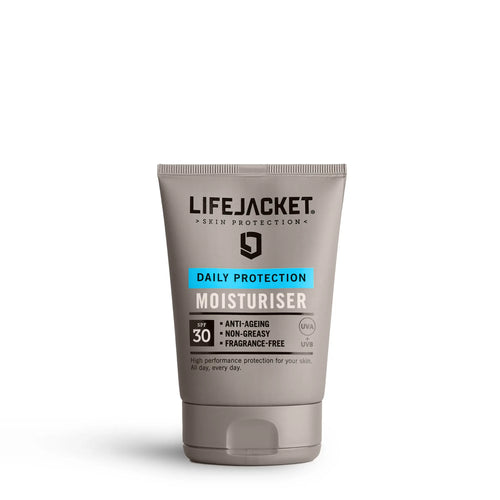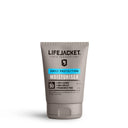Assuming you've been exercising outdoors a fair bit recently, you'll have spotted the Baltic temperatures. And if you're in that camp, it's worth knowing your skin needs a bit of extra TLC in this weather. The willpower to head out in this weather is admirable but sadly, it's not going do much to keep your skin happy and in good condition. That's why it might be time to take control with a good skin protection routine.
To learn more, we spoke to Professor Christian Aldridge, LifeJacket's consultant dermatologist, to get the best advice on how to look after your skin when exercising outdoors this winter.
What are the problems for your skin when exercising outside in winter?
Winter brings drops in temperature and humidity. Those two main elements cause an increased drying of the skin. When the air is very dry, water will leave your skin and then your skin will start to dry. If left and not moisturised, your skin starts to crack, certainly at the peripheries of the body, so the hands and face, tips of the nose and fingers. Then if not treated, it can go on to form a winter dermatitis, which is irritating, red, itchy changes on the surface of the skin. Both the cold weather and the low humidity allow these features to develop.
I get small, itchy swellings on my skin from the cold. What are they?
These are called chilblains and they occur as a reaction to cold temperatures.
That’s again caused by temperature. It usually affects the toes and fingertips, and is to do with the fact that the blood vessels there are quite small and vulnerable to temperature changes. With warm temperatures our faces and skin flush, go red, where the blood vessels open up. Conversely, when it’s cold, they will clamp down, so we have very white fingers and toes.
If it’s an extreme case, you can cause a spasm on the blood vessel which interrupts the blood supply to the surface of the skin, hence you get redness and sometimes scaling, crusting, soreness and pain in those digits which are relieved by rewarming. Some people are more prone to that – it can run genetically that you have increased susceptibility.
Is it necessary to moisturise after exercising outdoors in winter?
Absolutely. When we get home it’s usually nice and cosy, with the central heating on, which again is the enemy of the skin. That evaporates any remaining moisture out of your skin. Patients with eczema in general get worse in the winter because of the drying effects of central heating.
So have a shower, not too hot, and immediately after you dry, moisturise the skin. Definitely moisturise the bits that have been out and exposed because that improves the suppleness of the skin and allows it to recover.
Do you need to protect your skin from UV light during the winter?
I think people understand protection from ultraviolet light during the summer, and then during the winter you have more of a measured approach to it. So someone shopping on a rainy December day in a shopping mall doesn’t need sunscreen on their face. But the runner who’s out in all weathers running January to December really could do with additional protection, mainly in the form of a moisturiser with added protection, rather than a high-factor sunscreen on its own. The latter doesn’t make much sense in the winter unless you are in an Alpine resort or you’re skiing where the altitude will increase the UV potency and the white snow reflects UV light even more. Those individuals should use a high-factor sunscreen because your chances of burning are much higher, particularly your face.
So apart from the high-altitude settings, if you’re just running in the winter, then I think something like a daily moisturiser that also has an SPF of 30 is probably ideal for those all-weather runners. The same would apply to sailors and golfers, the people who have chronic exposure. A moisturiser plus an SPF all-in-one also mitigates against photoaging. A lot of ageing effects come with the weathering of the skin.
It’s much more of a tailored approach with winter sun protection. Experts really need to get the message right, otherwise people think we’ve lost the plot! Telling somebody to put sunscreen on in January when it’s snowing outside or it’s freezing and grey, it dilutes the message.
There are some categories and sections of the public who do spend a lot of time outside, who have that chronic exposure who probably benefit from sunscreen – like if you’re an all-weather runner. It adds up, it’s about chronic exposure. So it’s not just that you started doing it this year . Years go by and you can accumulate those exposures. You should be using a moisturiser with SPF if you’re out throughout the year, and then moisturising when you come home.






